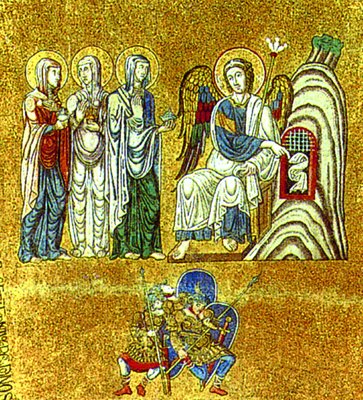A Scriptural Reflection on the Readings for Sunday, April 8, 2012, The Solemnity of Easter, the Resurrection of the Lord
It is something of a tradition for magazines and newspapers to run articles about the death and Resurrection of Jesus Christ in the weeks leading up to Easter. Scholars, pastors, skeptics, and ordinary people weigh in with their arguments and opinions. Some argue the Resurrection never took place. Down  through time there have been a number of arguments made about what really happened on that Sunday some two thousand years ago. Peter Kreeft and Fr. Ronald Tacelli, in Handbook of Catholic Apologetics, outline the four basic theories used to explain away the Resurrection.
through time there have been a number of arguments made about what really happened on that Sunday some two thousand years ago. Peter Kreeft and Fr. Ronald Tacelli, in Handbook of Catholic Apologetics, outline the four basic theories used to explain away the Resurrection.
The first is that a conspiracy existed to misrepresent what transpired in the aftermath of Jesus’ death. The most ancient variation of this argument was concocted by the chief priests upon discovering the empty tomb: the body of Jesus was stolen by his disciples (Matt 28:11-15).
The second is that the apostles and other disciples—nearly mad with grief and deeply confused—experienced the world’s most dramatic group hallucination. Convinced that they had seen and experienced the impossible, they set out to convince the world of the same.
Another argument—the “swoon theory”— is that Jesus, tortured and exhausted, had not died, but had only passed out for a time until he was revived by his followers.
The final argument, which has a loyal following in different forms among atheists, skeptics, and theologically liberal Christians, is that the Resurrection is a myth. Some insist this does away with the meaning of the Resurrection, while others insist this actually provides a deeper, metaphorical meaning.
There are, of course, many problems with each of these theories. For example, how exactly would a group of frightened fisherman overwhelm Roman guards and move away a huge stone? And why would they, only weeks later, fearlessly proclaim Christ’s Resurrection and then, over the years, accept martyrdom, despite knowing Jesus was actually dead? How is it that hundreds of people (cf., 1 Cor 15:3-8) experienced the same hallucination? How would Jesus, who was ripped to shreds and crucified by trained killers, appear shortly thereafter as physically whole, even glorious in appearance (Jn 20:19-29)?
But it is the theory of the mythical or metaphorical Resurrection that is most disconcerting, especially when embraced by Christians. In today’s reading from Acts, Peter is described stating bluntly, “They put him to death by hanging him on a tree. This man God raised on the third day and granted that he be visible, not to all the people, but to us.” The story of doubting Thomas (Jn. 20:19-29) soundly rejects any such understanding. And today’s Gospel readings all describe real confusion on the part of the disciples and the fact that this confusion was due to a physical Resurrection. “Do not be amazed!” the angel told the women, “You seek Jesus of Nazareth, the crucified. He has been raised; he is not here” (Mk 16:5-6).
The story of the two disciples journeying to Emmaus (Lk 24:13-35) emphasizes how belief in the Resurrection is not, in the end, a matter of mere reason or facts, but of a real encounter with the Risen Lord. Having walked and talked at length with Jesus, they still did not recognize him. But when he took break and blessed it and gave it to them—that is, when Jesus gave them Eucharist—their “eyes were opened and they recognized him.”
“The basic form of Christian faith,” Joseph Cardinal Ratzinger wrote in Faith and the Future (Ignatius, 2009), “is not: I believe something, but I believe you.” It’s not that faith is unreasonable; rather, it is finally, in the end, above and beyond reason, although never contrary to reason.
It is ultimately an act of will and love. “We believe, because we love,” wrote John Henry Newman in a sermon titled, “Love the Safeguard of Faith against Superstition.” “The divinely-enlightened mind sees in Christ the very Object whom it desires to love and worship,—the Object correlative of its own affections; and it trusts Him, or believes, from loving Him.”
(This "Opening the Word" column originally appeared in a slightly different form in the April 12, 2009, issue of Our Sunday Visitor newspaper.)
